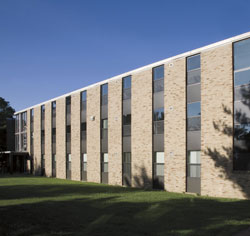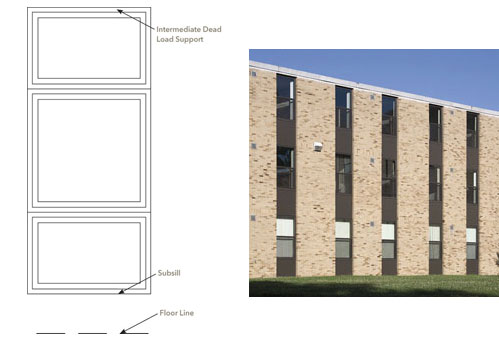Fiberglass Windows: A Sustainable Choice in Non-Residential and Multi-Family Buildings
Architects have another option for window systems in commercial and institutional building designs.
This course is no longer active
Peter J. Arsenault, FAIA, NCARB, LEED-AP
Vertically Stacked Windows
Design Recommendations
Similar to horizontal ribbons, the greater height of vertically stacked windows often requires special detailing, reinforcing mullions, intermediate dead load support, and subsills. Operable or fixed windows of the same width can be stacked vertically to a maximum height of ten feet without intermediate dead load support. Intermediate support is typically introduced at the floor lines to carry the weight of the windows above. (See Figure 14.) Â
|
Figure 14: Walsh University Alexis Hall utilizing vertically stacked window design
Images courtesy of Pella Corporation |
Case Study: Alexis Hall, Walsh University, Canton, OH
Architect: Motter & Meadows Architects
General Contractor: Fred Olivieri Construction Company |
 Walsh University needed windows that would withstand day-to-day use by college students, match the style of other buildings on campus, and save energy. Located on 85 sprawling acres and surrounded by an abundance of trees, Walsh University is a private college in Canton, Ohio. Alexis and Menard halls were built in 1968 and together house 400 students. The goal for this project was to replace the existing aluminum windows in Alexis Hall and build the Betzler Tower addition onto Menard Hall. The challenge was finding replacement and new construction windows that matched. The windows needed to be extremely durable and low-maintenance to handle use and abuse by college students, as well as to complement the architectural style of the halls and other campus buildings. The windows also had to be affordable and energy-efficient-so the students would have a comfortable living environment and the school would save on its energy costs. Walsh University needed windows that would withstand day-to-day use by college students, match the style of other buildings on campus, and save energy. Located on 85 sprawling acres and surrounded by an abundance of trees, Walsh University is a private college in Canton, Ohio. Alexis and Menard halls were built in 1968 and together house 400 students. The goal for this project was to replace the existing aluminum windows in Alexis Hall and build the Betzler Tower addition onto Menard Hall. The challenge was finding replacement and new construction windows that matched. The windows needed to be extremely durable and low-maintenance to handle use and abuse by college students, as well as to complement the architectural style of the halls and other campus buildings. The windows also had to be affordable and energy-efficient-so the students would have a comfortable living environment and the school would save on its energy costs.
Walsh University decided to install fiberglass windows for the new addition on Menard Hall and the Alexis Hall replacement project. The brown single-hung windows used for the vertical stacks "matched the buildings' colors and brought Menard Hall and Alexis Hall up to a standard that's acceptable to the university," said Mark Bosko, director of university relations for Walsh University. Installation of Alexis Hall's replacement windows, however, proved to be a challenge. The 40-year-old, clear anodized aluminum windows had been caulked several times and had a brown aluminum panel at each floor line. The existing windows sat flush with precast floors, complicating the installation of new windows. To ensure optimum installation performance, an innovative installation solution was developed at the spandrel locations to cover the concrete slab, seal the windows and prevent joints from showing. The new dark-brown fiberglass windows give a consistent, modern and clean look to the building-and create a place students can be proud to call home.
|
Originally published in December 2010






 Walsh University needed windows that would withstand day-to-day use by college students, match the style of other buildings on campus, and save energy. Located on 85 sprawling acres and surrounded by an abundance of trees, Walsh University is a private college in Canton, Ohio. Alexis and Menard halls were built in 1968 and together house 400 students. The goal for this project was to replace the existing aluminum windows in Alexis Hall and build the Betzler Tower addition onto Menard Hall. The challenge was finding replacement and new construction windows that matched. The windows needed to be extremely durable and low-maintenance to handle use and abuse by college students, as well as to complement the architectural style of the halls and other campus buildings. The windows also had to be affordable and energy-efficient-so the students would have a comfortable living environment and the school would save on its energy costs.
Walsh University needed windows that would withstand day-to-day use by college students, match the style of other buildings on campus, and save energy. Located on 85 sprawling acres and surrounded by an abundance of trees, Walsh University is a private college in Canton, Ohio. Alexis and Menard halls were built in 1968 and together house 400 students. The goal for this project was to replace the existing aluminum windows in Alexis Hall and build the Betzler Tower addition onto Menard Hall. The challenge was finding replacement and new construction windows that matched. The windows needed to be extremely durable and low-maintenance to handle use and abuse by college students, as well as to complement the architectural style of the halls and other campus buildings. The windows also had to be affordable and energy-efficient-so the students would have a comfortable living environment and the school would save on its energy costs.



